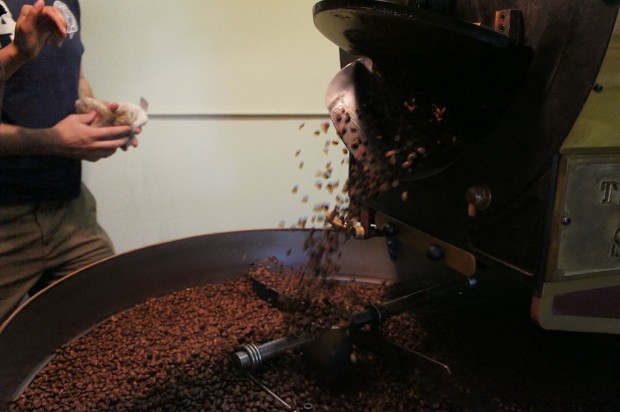(Note: This is part four in our four-part series on commercial roastery planning and pitfalls. For additional resources, see part 1 on equipment selection, part 2 on space management, and part 3 on permitting and inspections.)
You’ve witnessed walls go up, equipment installed, and permits approved. By now your operation will have needed some people. Solid people are by far the most important addition to your nascent roasting empire, and you should spend as much time as necessary to find the right ones. Dedicated coffee professionals, warehouse managers, and skilled artisans all have a home in any coffee roasting facility, even if the process of hiring them can seem daunting, especially for smaller enterprises.
“Pretty much anyone you know in the coffee industry is going to be excited about roasting,” remarked Slate Coffee Roasters‘ Chelsey Walker-Watson. And yet, just because someone aspires to do a thing that they might even truly love in the beginning doesn’t mean that their personality will jibe with the task in the long term. Baristas, for example, often show excitement for the possibility of roasting, though it’s important that any applicant understands that while being a barista is a very social, fast-paced and public-facing position in the hip, trendy specialty coffee industry, roasting is largely a solitary and systematic pursuit.
The roastery worker is glued to a machine that’s ten times larger, several times hotter, and generally louder. There may be far less conversation involved in the daily routine of roasting, which can make production work such as bagging and labeling less fun than the repetitive side-tasks around a cafe. Apart from the shared focus on coffee and craft, the unseen industrial nuts and bolts of roasting are practically opposite those of the bustling service counter, which is an important consideration both for the employees and decision-making employers.
That said, once your staff is selected and starts the job, they will spend between two weeks to a month learning and honing their skills through on-the-job training. Then efficiency and productivity will increase. So how does one make good on that investment of time and education by retaining the employees that make it to this point?
Leadership. Good leadership is what guides businesses to smooth and efficient operation and growth by minimizing waste in all its forms. This includes the loss of goods and materials through sloppy work, the loss of water or power due to poor maintenance or irresponsible practices, and the loss of time, productivity and morale due to employee turnover.
An interesting case for good leadership has been made by Cornerstone OnDemand, a consulting firm hired to assist with customer retention at one of Rupert Murdoch’s many publications in the UK. In an interview with Freakonomics Radio, they highlighted their findings after studying both customer-employee interaction and employee turnover. Regarding the latter, they asked a simple question to employees on the sales and retention team: “How do we keep you happy and productive?”
It turned out not to be with raises, pats on the back, or free coffee. A better supervisor was said to be more powerful than all these carrots combined. A 10-percent pay increase only accounted for a five-percent reduction in quitting, and even that effect only lasted from one week to one month. That’s not to say a great employee does not deserve a pay increase, but you’ll keep them on your staff even longer if you supervise them properly.
The Cornerstone findings illustrate that supportive, inspiring supervision more often translates to better performance by workers, which is what leads to customer satisfaction and a profitable business. After spending thousands of dollars building, prepping and finally launching your operation, it’s senseless to jeopardize it or your own healthy work-life balance by losing employees left and right.
A roasting operation, at its most basic level, needs to maintain a master roaster, an apprentice roaster, a production specialist for bagging and prepping orders, and a warehouse manager. In smaller operations, this can be two or three people wearing multiple hats. This in turn means cross-training workers in order to manage absences, vacation times, and personnel inevitably leaving your operation, although cross-training is also beneficial in that it keeps workers learning and engaged in a variety of angles within the business. What’s important to keep in mind is that the need to hire more people onto a stretched-too-thin staff is a much easier situation to remedy than the morale-degrading opposite scenario of needing to let people go.
In closing, ensure that you keep your eye on the big picture. What is it you want to accomplish now that you’re ready to roast? The satisfaction and development of your employees should play a part not only in your immediate short term goals, but your long term goals as well. Mentoring and training are crucial undertakings at every stage, for when you find yourself adding man-hours to the roasting schedule or acquiring a new piece of equipment, you’ll have a capable team ready to help you set up, welcome, and train the new members of your team.
Andrew Russo
Andrew Russo is the Coffee and Strategy Specialist at Catalyst Coffee Consulting.
Comment
2 Comments
Comments are closed.







What about a sales and marketing team? Specifically, what to look for in the people that will have direct communication with your customers?
As my business grows and my own time continues to shrink, who will I entrust with distribution? Giving the responsibility of answering questions and communicating with the customer, seems as difficult as it would be to have someone else on the roaster.
Tim
Growing means to let go. Find someone externaly, or give a career to one of your existing barista’s. No they won’t have the same Passion as you, but they will get the job done once you made clear what you expect from them.